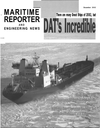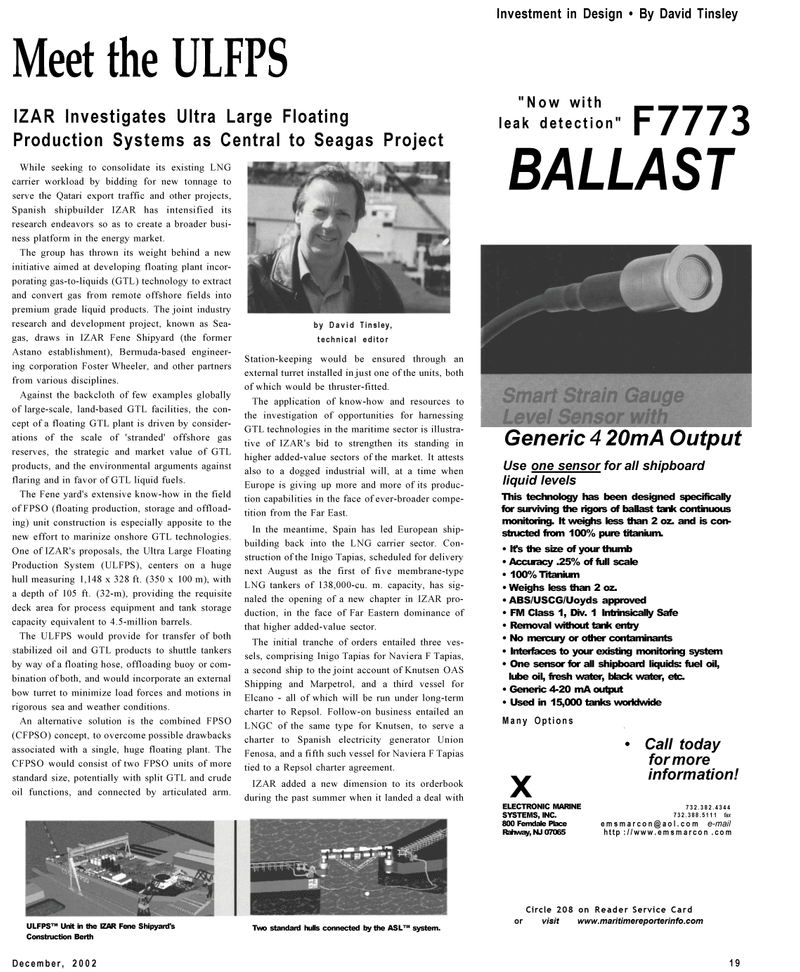
Page 19: of Maritime Reporter Magazine (December 2002)
Read this page in Pdf, Flash or Html5 edition of December 2002 Maritime Reporter Magazine
Investment in Design • By David Tinsley
Meet the ULFPS
IZAR Investigates Ultra Large Floating
Production Systems as Central to Seagas Project
While seeking to consolidate its existing LNG carrier workload by bidding for new tonnage to serve the Qatari export traffic and other projects,
Spanish shipbuilder IZAR has intensified its research endeavors so as to create a broader busi- ness platform in the energy market.
The group has thrown its weight behind a new initiative aimed at developing floating plant incor- porating gas-to-liquids (GTL) technology to extract and convert gas from remote offshore fields into premium grade liquid products. The joint industry research and development project, known as Sea- gas, draws in IZAR Fene Shipyard (the former
Astano establishment), Bermuda-based engineer- ing corporation Foster Wheeler, and other partners from various disciplines.
Against the backcloth of few examples globally of large-scale, land-based GTL facilities, the con- cept of a floating GTL plant is driven by consider- ations of the scale of 'stranded' offshore gas reserves, the strategic and market value of GTL products, and the environmental arguments against flaring and in favor of GTL liquid fuels.
The Fene yard's extensive know-how in the field of FPSO (floating production, storage and offload- ing) unit construction is especially apposite to the new effort to marinize onshore GTL technologies.
One of IZAR's proposals, the Ultra Large Floating
Production System (ULFPS), centers on a huge hull measuring 1,148 x 328 ft. (350 x 100 m), with a depth of 105 ft. (32-m), providing the requisite deck area for process equipment and tank storage capacity equivalent to 4.5-million barrels.
The ULFPS would provide for transfer of both stabilized oil and GTL products to shuttle tankers by way of a floating hose, offloading buoy or com- bination of both, and would incorporate an external bow turret to minimize load forces and motions in rigorous sea and weather conditions.
An alternative solution is the combined FPSO (CFPSO) concept, to overcome possible drawbacks associated with a single, huge floating plant. The
CFPSO would consist of two FPSO units of more standard size, potentially with split GTL and crude oil functions, and connected by articulated arm. by David Tinsley, technical editor
Station-keeping would be ensured through an external turret installed in just one of the units, both of which would be thruster-fitted.
The application of know-how and resources to the investigation of opportunities for harnessing
GTL technologies in the maritime sector is illustra- tive of IZAR's bid to strengthen its standing in higher added-value sectors of the market. It attests also to a dogged industrial will, at a time when
Europe is giving up more and more of its produc- tion capabilities in the face of ever-broader compe- tition from the Far East.
In the meantime, Spain has led European ship- building back into the LNG carrier sector. Con- struction of the Inigo Tapias, scheduled for delivery next August as the first of five membrane-type
LNG tankers of 138,000-cu. m. capacity, has sig- naled the opening of a new chapter in IZAR pro- duction, in the face of Far Eastern dominance of that higher added-value sector.
The initial tranche of orders entailed three ves- sels, comprising Inigo Tapias for Naviera F Tapias, a second ship to the joint account of Knutsen OAS
Shipping and Marpetrol, and a third vessel for
Elcano - all of which will be run under long-term charter to Repsol. Follow-on business entailed an
LNGC of the same type for Knutsen, to serve a charter to Spanish electricity generator Union
Fenosa, and a fifth such vessel for Naviera F Tapias tied to a Repsol charter agreement.
IZAR added a new dimension to its orderbook during the past summer when it landed a deal with
ULFPS™ Unit in the IZAR Fene Shipyard's
Construction Berth
Two standard hulls connected by the ASL™ system. "Now with leak detection"
BALLAST
Generic 4 20mA Output
Use one sensor for all shipboard liquid levels
This technology has been designed specifically for surviving the rigors of ballast tank continuous monitoring. It weighs less than 2 oz. and is con- structed from 100% pure titanium. • It's the size of your thumb • Accuracy .25% of full scale • 100% Titanium • Weighs less than 2 oz. • ABS/USCG/Uoyds approved • FM Class 1, Div. 1 Intrinsically Safe • Removal without tank entry • No mercury or other contaminants • Interfaces to your existing monitoring system • One sensor for all shipboard liquids: fuel oil, lube oil, fresh water, black water, etc. • Generic 4-20 mA output • Used in 15,000 tanks worldwide
Many Options • Call today for more information! 732.382.4344 732.388.5111 fax [email protected] e-mail http ://www.emsmarcon .com
Circle 208 on Reader Service Card or visit www.maritimereporterinfo.com
F7773 x
ELECTRONIC MARINE
SYSTEMS, INC. 800 Ferndale Place
Rahway, NJ 07065
December, 2002 19

 18
18

 20
20
